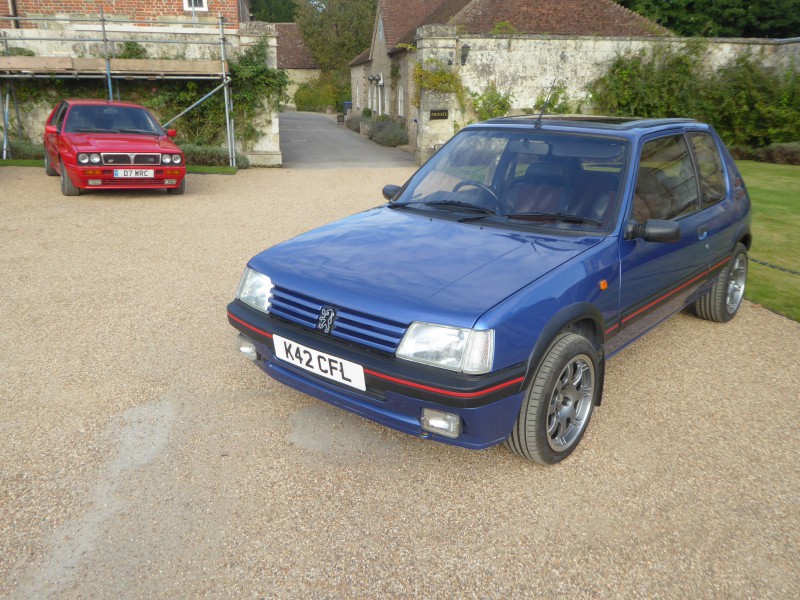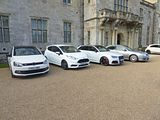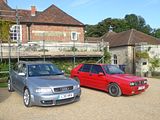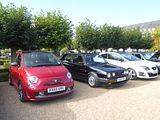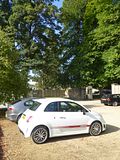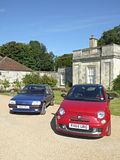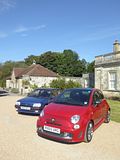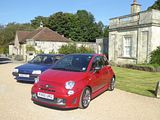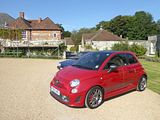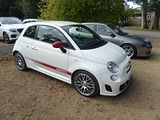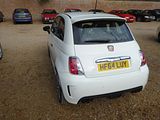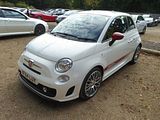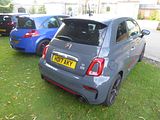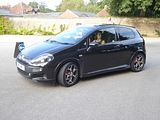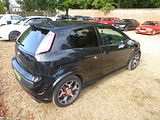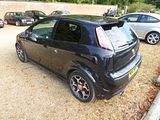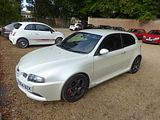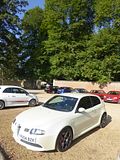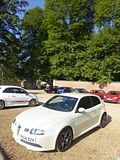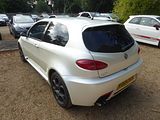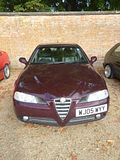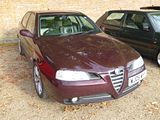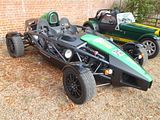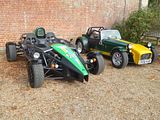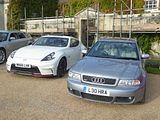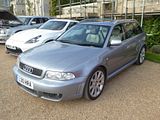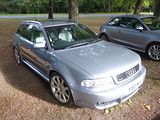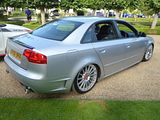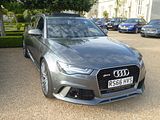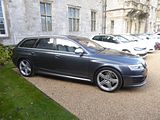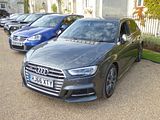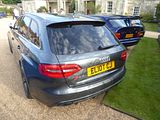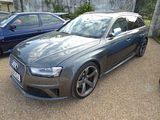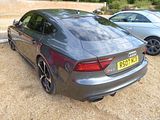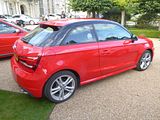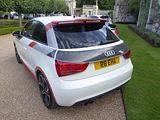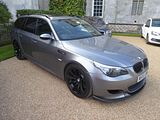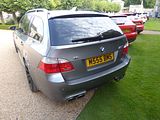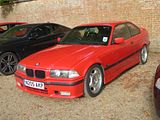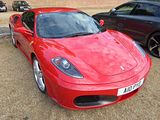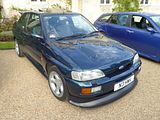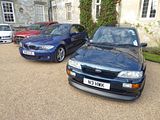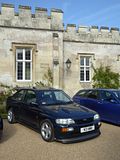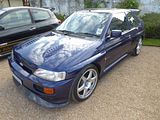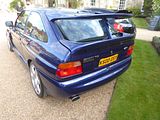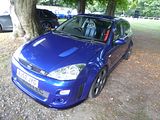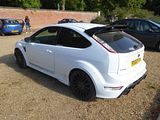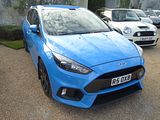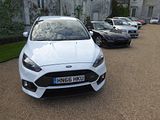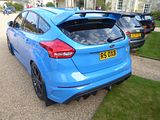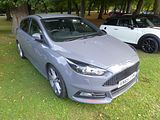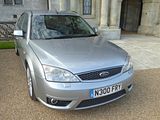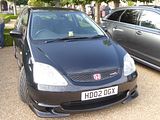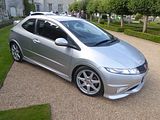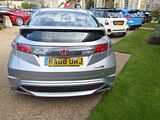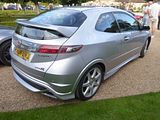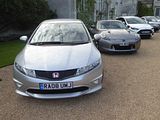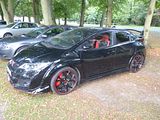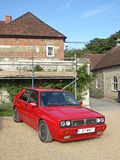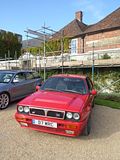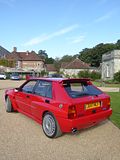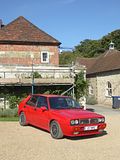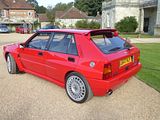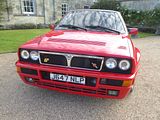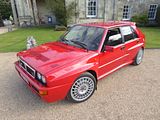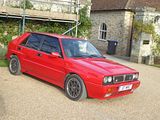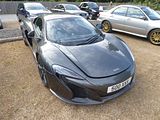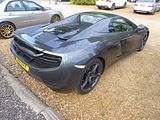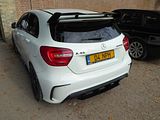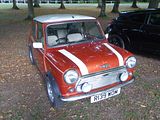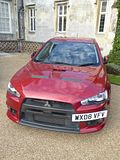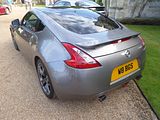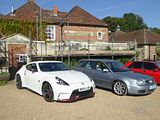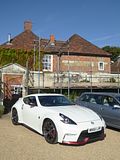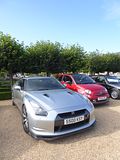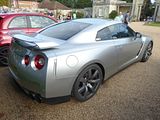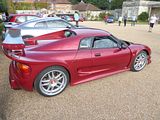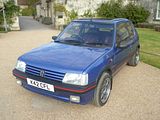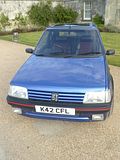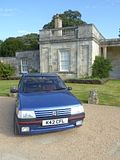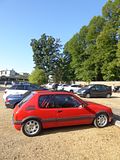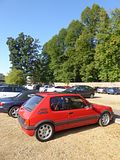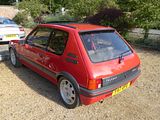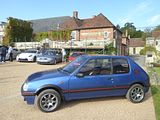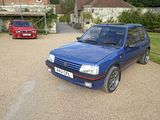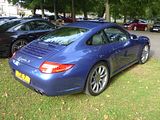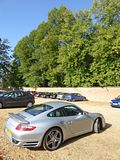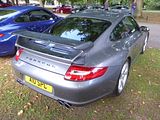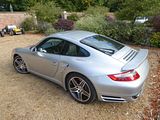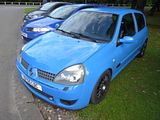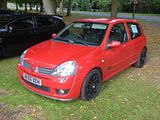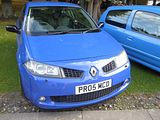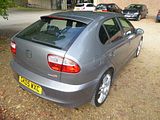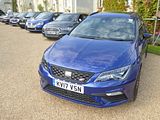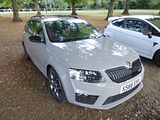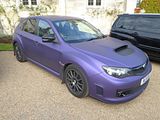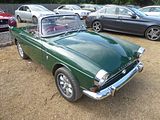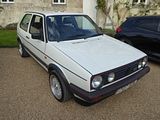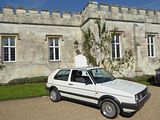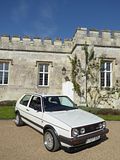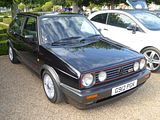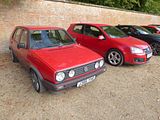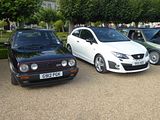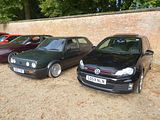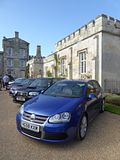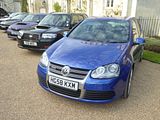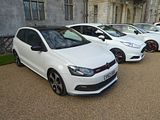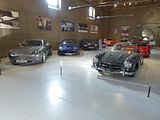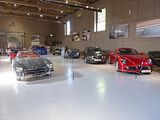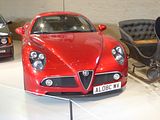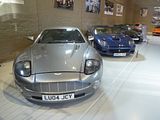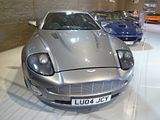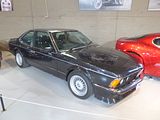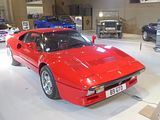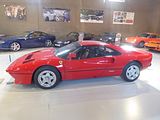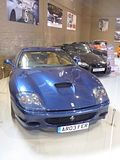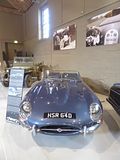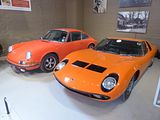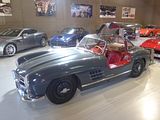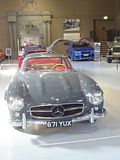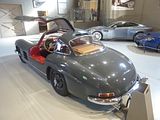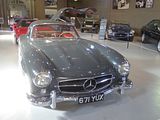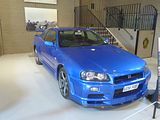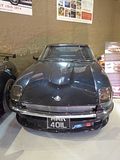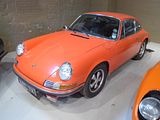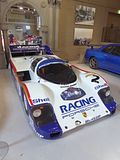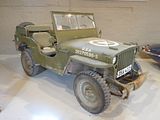There was much disappointment when the news broke earlier this year that the hugely popular Wilton House Supercar event, pended for a year in 2017 whilst plans were put in place for something “even more exciting” in 2017, was not going to go ahead, and that the event was unlikely “ever to return”. No explanation was given at the time, beyond “factors beyond our control”, and none has been provided since. There was at least the consolation that this rather splendid venue, home to the Earl of Pembroke, a die-hard Petrolhead, would continue to host the popular “Wilton Wake Ups” during the coming year. Established a couple of years ago, these are effectively Breakfast Club type meets that take place once a month between April and September, wit each having a theme. On a first come basis, cars that comply with the theme get the chance to park in the courtyard to the east of the house, and those that don’t, or when the courtyard is full, can spill over into the main public car park a hundred or so yards away. All told there is ample space for the cars that typically turn up, and the selection of a different theme each time does ensure a nice variety of cars, unlike some other Breakfast Clubs which can get a bit same-y month after month. The events diary is sufficiently congested that I was never likely to be able to attend all of the 2017 events, but I did spot a gap in August, on the Sunday of the Bank Holiday weekend (surprisingly!) which meant that I decided to pop along for the second tine in the year. With a theme of “Hot Hatches and Estates”, it made it an easy choice as to which car to clean up and to use for the one hour or so from Bristol to Bath and down the A36 to get there. I arrived early, which meant that I got one of the positions in the centre of the courtyard. It soon filled up, and there was plenty to see on what became an ever sunnier morning. Here are my findings:
ABARTH
For a while, my Competizione 180 was the only Abarth present, but as the minutes of the morning ticked by, it was joined by a couple of others. The final tally was three of the 500-based cars and one Punto.
Something that few had seen before, as these cars have only recently started reaching their owners was this 695 XSR Yamaha. From what I heard other people saying – most of whom I did not try to correct! – there is plenty of mis-information out there as to what exactly this is. Despite the 695 name, it is not the same as the earlier Tributo Ferrari cars, as I heard several say, and nor is it a Biposto variant. Genesis of the car, and its name, is that for the third year running, Abarth is the Official Sponsor and Official Car Supplier of the Yamaha Factory Racing Team in the 2017 FIM MotoGP World Championship. And so, in the wake of the thrilling Abarth 595 Yamaha Factory Racing and the 695 biposto Yamaha Factory Racing Edition, along came the Abarth 695 XSR Yamaha Limited Edition special series, available exclusively with a Pista Grey livery: only 695 examples of each of the hatch and convertibles will be made. This version was created to celebrate the Yamaha XSR900 Abarth, which is the first exclusive motorcycle to spring from the collaboration between the two brands and which sports the same grey livery with red trim as the 695 XSR, as well as sharing many of its features. The special series makes extensive use of carbon fibre to demonstrate its affinity with the front fairing, front mudguard and saddle cover of the two-wheel Yamaha. The Abarth 695 XSR and the Yamaha XSR900 Abarth also share Akrapovič ultralight exhaust developed in the racing world to boost the personality, sound and performance of both vehicles. On the Abarth car, the carbon fibre tailpipes enhance the looks and technology of the exhaust system. The XSR logo on the tailgate distinguishes the Abarth 695 XSR, while an aluminium badge identifies the sequential number of 695 units for each body type. Other carbon fibre details, in addition to the mirror caps and Akrapovič tailpipes, are available as optional equipment, such as dashboard fascia, pedal covers, gear knob and kick plate. Despite the 695 badging, the car is powered by a 165 bhp version of the 1.4 T-Jet engine. Equipment on this special series includes Koni rear suspension and Eibach springs, 17” Supersport alloy rims with Matt Black finish, Satin Chrome accents on handles and badge supports, red details on bumpers and mirrors, red brake callipers and a braking system with perforated discs. This version can be customised even further using the tuning kit to increase the power to 180 bhp, improve handling by fitting a Koni front suspension with FSD (Frequency Selective Damping) valve and make braking even prompter with 305x28mm perforated and self-ventilating Brembo floating front discs with high-performance Ferodo HP 1000/1 front brake pads. It also features the new UconnectTM 7″ HD LIVE system integrated with Apple CarPlay allows iPhone users to access contents such as Apple Maps, Messages, telephone calls, Apple Music, also with Siri voice assistance. There are plenty of prospective owners still waiting for their cars to arrive at the dealers, though whether any of them were here, I don’t know.
Final Abarth here was a Punto Evo, a model that is starting to become quite rare at events. Around 370 of these were sold between 2010 and the end of 2014, and their numbers have reduced a bit for all the reasons that car populations diminish (!) but there are still around 300 left on our roads.
ALFA ROMEO
Arriving rather too late to get in the main courtyard area was this fabulous 147GTA. Unlike the rest of the 147 range the GTA version had a rather short production life. Launched in 2002. this car was intended to compete with the most sporting Golf and Focus models of the day. as well as injecting more potency into a range which always seemed like it needed more power. Fitted with a 3.2 V6 engine which produced 247 bhp, the 147GTA was the most powerful hot hatch available at the time, and the modifications to the body, including lower sills and wider wheel arches, if anything, made it look even better rather than endowing it with the sort of “after market look” that can afflict some high end performance versions of regular family cars. Performance figures were impressive, with the car able to achieve a top speed of 153 mph. It had a widened body by 15 mm at each side to accommodate the 225/45R17 tyres. Most models had a 6-speed manual transmissions; whilst a smaller number of other models used the semi automatic Selespeed system. Production ran through to 2004 and in total 5,029 147 GTAs were built, 1004 of which were Selespeeds. Only around 300 came to the UK, so this was never a common sighting on British roads.
The other Alfa here was equally rare. A facelifed 166 is not a common sight anyway, and the burgundy colour of this one made it particularly unusual. Alfa followed the much-praised 156 of 1997 less than two years later, in late 1998, with a larger saloon, the 166, hoping to receive the same sort of acclaim with this executive car which was a direct replacement for the 164. It was not forthcoming. For a start, the styling with its drooping and very small headlamps and pointed nose was quite unlike anything else on the market at the time. Part of the difficulty came from the fat that the car had been designed some years before its launch and then put on the back burner as the 156 was given priority. The 166 was initially available with a 155 PS 2.0-litre Twin Spark, a 190 PS 2.5 V6, a 220 PS 3.0 V6 and in some markets a 205 PS V6 2.0 Turbo petrol engine along with a diesel powered L5 2.4 10v common rail turbodiesel version with 136 PS, 140 PS and 150 PS (148 hp) output. The 2.0 TS model used a 5-speed manual gearbox, whilst the 2.5 and 3.0 had the option of a Sportronic automatic gearbox. The 3.0 V6, L5 2.4 and V6 Turbo were otherwise supplied with a six-speed manual gearbox. The top models were named “Super”, and included MOMO leather interior, 17″ alloy wheels, rain sensitive wipers, cruise control, climate control and ICS (Integrated Control System) with colour screen. Options included xenon headlamps, GSM connectivity and satellite navigation. Suspension systems comprised double wishbones at the front and a multi-link setup for the rear. Though the car’s handling characteristics, engine range and elegant exterior design received praise from many, including Top Gear’s Jeremy Clarkson, it did not become a strong seller to rival the dominant German brands, in the European executive car sector. In September 2003, the 166 underwent a substantial revamp, with the début at the Frankfurt Motor Show. As well as upgrades to the chassis, interior, and the engine range, the styling was substantially altered. The new front end resembled the also recently revamped 156, and lost its famous drooping headlights. The 2.0 V6 Turbo model was dropped because of marketing problems, the V6 2.5 was re-rated at 188 PS and a 3.2 litre V6 with 240 PS was introduced. Both the 3.2 litre and the 2.0 Twin Spark models now featured the six-speed manual gearbox, whilst the 3.0 model was retained, but made available only in Sportronic form. In the diesel sector, the L5 2.4 was re-engineered with Multi-Jet technology which allows up to 5 injections per cycle, second stage common rail, with maximum injection pressure of 1400 bar and 4 valves per cylinder, to output a class leading 175 PS, but these changes made little impact on sales volumes. In October 2005, the Alfa Romeo 166 was officially withdrawn from sale in markets for RHD. Sales of the 166 never grew as Alfa had hoped, following the facelift in September 2003, and the additional lack of a diesel engine in the United Kingdom, Australian, and Irish markets limited its reach into company car sectors. In June 2007, production of the 166 effectively ended, with no direct successor. In September 2008, the platform was sold to the Chinese state run manufacturer GAC Group. In total, less than 100,000 units were made.
ARIEL
Parked alongside a Caterham was this Atom 3.5R. Not a hatch or estate for sure, but no question that thanks to its lightweight construction, its performance could hardly be described as anything other than decently hot. The Atom, popular primarily as a track day car, was first seen in public at the British International Motor Show at the NEC in Birmingham in October 1996, the result of a student project by Coventry University transport design student, Niki Smart. Known then as the LSC (Lightweight Sports Car), it was developed at the university in 1996 with input and funding from various automotive industry members, including British Steel and TWR. Ariel Motor Company boss Simon Saunders was a senior lecturer whose responsibility for the project was primarily as financial manager and design critic for Smart, whom he described as “The best all-round design student I’ve ever seen.” Since then, an operation was created in Crewkerne, Somerset, and around 100 cars a year are produced there. Each one is made by a single person, who undertakes everything from assembly to final road test before putting his name on the finished product. There have been 7 distinct models, with a wide variety of different engines ranging from a 2 litre Honda VTEC unit in naturally aspirate and supercharged guise, to the ultimate, the 500, with a 3 litre V8 that generates 500 bhp. Visually, the cars look similar at a quick glance, and it takes a real marque expert (which I am not!), to tell them apart.
AUDI
One of the best represented marques here was Audi, with a number of mainly RS models here, which are bang on theme, of course. Oldest of these were the duo of B5 generation RS4 Avant models. These date from an era when Audi only produced one RS model at a time, meaning that the variant had quite a short production life. Introduced by Audi in late 1999, for main production and sale from 2000, this was effectively the successor to the Porsche / quattro GmbH joint venture-developed Audi RS2 Avant that was sold in the mid 1990s. Like its RS2 predecessor, it was available only as an Avant. Although related to the Audi B5 S4, many of the outer body panels were altered, with wider front and rear wheel arches, to allow for the wider axle track on the RS 4. With unique front and rear bumpers and side sills, and the rear spoiler from the S4 Avant, the aerodynamic modifications achieved a drag coefficient of Cd 0.34 and a very purposeful look, especially when finished in a sober colour such as the two examples seen here. It was the mechanical changes, though, which had the huge difference. The engine was developed from the 2.7 litre V6 ‘biturbo’ used in the B5 S4, and retained the same 2,671 cc capacity, but much was changed. Developed and manufactured in the UK by Cosworth Technology, it featured enlarged intake and smaller exhaust ports on the two Cosworth cast aluminium alloy cylinder heads, two parallel BorgWarner turbochargers, two larger side-mounted intercoolers, dished piston crowns, stronger connecting rods, larger intake ducting, enlarged exhaust system, and a re-calibrated engine management system. The modifications increased the engine’s output from 265 bhp to 375 bhp at 7,000 rpm, and with 325 lb/f·ft of torque. The engine was controlled by a Bosch Motronic ME 7.1 electronic engine control unit (ECU), using a Bosch ‘E-Gas’ electronic drive by wire throttle. The engine had multipoint sequential fuel injection, a MAF, six individual single-spark coils and NGK longlife spark plugs. The engine oil was cooled by a dual oil:water cooler and an oil:air cooler. There was a 6 speed manual transmission and Audi’s Torsen-based quattro system. Even with a kerb weight of 1,620 kilograms (3,571 lb), the RS 4’s powerful engine gave it the performance of a sports car. 100 km/h could be reached from rest in 4.9 seconds, 160 km/h in 11.3 seconds, and 200 km/h in 17.0 seconds. Top speed was electronically limited to 262 km/h(162.8 mph) Audi produced 6,030 units between 1999 and 2001.
This is a DTM version of the Audi A4. It was a special edition model produced in 2005 to commemorate Audi’s first championship title in the 2004 German Touring Car Masters (DTM). The Audi A4 race car won everything it could that season (drivers’, manufacturers’ and teams’ titles), so quattro GmbH wanted to bring some of that sporting character back to its base model. The regular saloon Audi A4 received an engine update of 20 horsepower (from 200 hp) and featured some redesigned exterior lines: new bumper with additional air intakes, larger tailpipes, restyled diffuser and sportier suspensions. Needless to say, this model was also equipped with a revised quattro permanent all-wheel-drive system.
With RS models of much of the range available these days, it was no surprise to find several current or recent cars here, especially since Audi have remained faithful to the idea of the uber-fast estate, ever since that first RS2 of the 1994. So parked up in the display was the current thunderous RS6, only sold in Avant guise, the recently superceded B8 generation RS4 Avant, and a couple of the RS3 Sportback, which, having driven one for myself, I can confidently say are far better than the UK press would have us believe.
Final RS model here was an RS7, the most potent of the RS range, with its 4.0 TFSI twin scroll twin turbo V8 engine rated at 553 bhp and 516 lb·ft. The RS7 is full of advanced technology, with a cylinder on demand system which deactivates intake and exhaust valves of 4 cylinders (2, 3, 5 and 8), eight-speed tiptronic transmission with D and S driving modes, quattro with torque vectoring with self-locking centre differential with a high locking rate and oil cooler, polished 20-inch forged wheels in a seven twin-spoke design (with optional 21-inch cast wheels in a choice of three designs), four internally vented diameter brake discs with 15.35 in diameter front discs and black (optional red) painted six-piston calipers (optional 420 mm (16.54 in) carbon fibre ceramic discs with anthracite gray calipers), electronic stabilisation control with Sport and off modes, adaptive air suspension lowering body by 20 mm (optional tauter sport suspension plus with Dynamic Ride Control), optional Dynamic all-wheel steering with continuously variable steering boost and ratio. The RS7 is easy to identify from lesser models in the range with its high-gloss black protective grille with honeycomb structure at the front of the car, add-on parts in matt aluminium, power extending spoiler, two elliptical tailpipe trims, a choice of 10 body colours (including Nardo gray, exclusive finish Daytona gray, matt effect), optional matt aluminium and carbon styling packages. It was unveiled at the 2013 North American Show in Detroit, and probably sells more strongly in the US than in Europe, as that thunderous engine does have a CO2 penalty, efficient though it maybe given the performance on offer. That was no deterrent to Audi from introducing an even more potent version, though, with the RS7 Performance, along with the RS6 Performance being released in October 2015. This is powered by the same 4.0-litre twin-turbo V8 engine as the standard RS7, but now with 597 bhp and 553 lb·ft. The top speed remains limited to 250 km/h (155.3 mph) as standard, and there are optional Dynamic and Dynamic Plus packages that raise the top speed to 174.0 and 189.5 mph respectively. The RS7 performance will accelerate from 0 to 100 km/h (62.1 mph) in 3.7 seconds and 0 to 200 km/h (124.3 mph) in 12.1 seconds. Despite the improved performance, the fuel economy and CO2 are unchanged from the standard RS6 Avant. A very desirable car.
Despite rumours that suggest Audi is working on an RS version of their smallest model, the fastest regular production version of the model remains the S1, and there was one of these here.This was launched in 2015, with a 227 bhp engine derived from the Volkswagen group’s EA888 2.0 litre turbo four cylinder, and permanent quattro four wheel drive, enough to allow the standard car to accelerate from 0-60 mph in 5.6 seconds and on to a limited top speed of 155 mph. Before this was launched there were a number of very limited edition cars, with more power than the standard ones and some of the special features of these were offered as part of the accessories program for the A1 family. Among these, and certainly the most distinctive are the decals from the Clubsport Quattro, with adhesive film decals in the contrasting colours of Amalfi White, Ice Silver, metallic and Daytona Gray, pearl effect for the vehicles’ shoulders, and a car with these fitted was also to be seen here.
BMW
There were a couple of BMWs here. One was in the main courtyard, and rightly so, too, as this was an E60 M5 Touring, It is the only generation of M5 to have been offered with the Touring body. The E60 M5 was introduced in 2005, with an uneven firing V10 engine and 7 speed sequential manual gearbox linking the car with the BMW Sauber Formula One program. The E60 M5 was the world’s first production sedan to feature a V10 petrol engine. A 7 speed sequential manual gearbox (SMG III) was available, and a six-speed manual transmission gearbox was available for the US only. As with some of its predecessors, the E60 variant of the M5 was both the quickest and fastest 4-door sedan in the world at the time of its release. Other unique M5 features include a wider track, unique body panels, 7-speed SMG III sequential manual gearbox, also known as a single-clutch automated manual transmission, a colour heads up display featuring navigation, control messages, speed, rpm and gear selection information, automated seat side bolsters, heated/ventilated seats and power rear curtain. The larger, flared front guards on either side also featured cooling vents, reminiscent of the 1970s BMW CSL. The wheels were of a standard 19″ diameter with quad exhaust pipes to the rear. The E60 M5 was the most successful M5, despite being on the market for one year less than the E39 M5. During its five-year run, 20,548 units were built composing of 19,523 saloons and 1,025 wagons. the US was the biggest market, with 8,800 sold there, all of the saloon variety. Great Britain and Ireland claimed 1,776 examples, which was 120 more than were sold in BMW’s home market of Germany.
To be found in the main car park was this E36 3 Series.
FERRARI
Parked in the main car park was the sole Ferrari of the morning, an F430. Successor to the Ferrari 360, this model debuted at the 2004 Paris Motor Show. Designed by Pininfarina, under the guidance of Frank Stephenson, the body styling of the F430 was revised from its predecessor, the Ferrari 360, to improve its aerodynamic efficiency. Although the drag coefficient remained the same, downforce was greatly enhanced. Despite sharing the same basic Alcoa Aluminium chassis, roof line, doors and glass, the car looked significantly different from the 360. A great deal of Ferrari heritage was included in the exterior design. At the rear, the Enzo’s tail lights and interior vents were added. The car’s name was etched into the Testarossa-styled driver’s side mirror. The large oval openings in the front bumper are reminiscent of Ferrari racing models from the 60s, specifically the 156 “sharknose” Formula One car and 250 TR61 Le Mans cars of Phil Hill. Designed with soft-top-convertible. The F430 featured a 4.3 litre V8 petrol engine of the “Ferrari-Maserati” F136 family. This new power plant was a significant departure for Ferrari, as all previous Ferrari V8’s were descendants of the Dino racing program of the 1950s. This fifty-year development cycle came to an end with the entirely new unit. The engine’s output was 490 hp at 8500 rpm and 343 lb/ft of torque at 5250 rpm, 80% of which was available below 3500rpm. Despite a 20% increase in displacement, engine weight grew by only 4 kg and engine dimensions were decreased, for easier packaging. The connecting rods, pistons and crankshaft were all entirely new, while the four-valve cylinder head, valves and intake trumpets were copied directly from Formula 1 engines, for ideal volumetric efficiency. The F430 has a top speed in excess of 196 mph and could accelerate from 0 to 100 km/h in 3.9 seconds, 0.6 seconds quicker than the old model. The brakes on the F430 were designed in close cooperation with Brembo (who did the calipers and discs) and Bosch (who did the electronics package),resulting in a new cast-iron alloy for the discs. The new alloy includes molybdenum which has better heat dissipation performance. The F430 was also available with the optional Carbon fibre-reinforced Silicon Carbide (C/SiC) ceramic composite brake package. Ferrari claims the carbon ceramic brakes will not fade even after 300-360 laps at their test track. The F430 featured the E-Diff, a computer-controlled limited slip active differential which can vary the distribution of torque based on inputs such as steering angle and lateral acceleration. Other notable features include the first application of Ferrari’s manettino steering wheel-mounted control knob. Drivers can select from five different settings which modify the vehicle’s ESC system, “Skyhook” electronic suspension, transmission behaviour, throttle response, and E-Diff. The feature is similar to Land Rover’s “Terrain Response” system. The Ferrari F430 was also released with exclusive Goodyear Eagle F1 GSD3 EMT tyres, which have a V-shaped tread design, run-flat capability, and OneTRED technology. The F430 Spider, Ferrari’s 21st road going convertible, made its world premiere at the 2005 Geneva Motor Show. The car was designed by Pininfarina with aerodynamic simulation programs also used for Formula 1 cars. The roof panel automatically folds away inside a space above the engine bay. The conversion from a closed top to an open-air convertible is a two-stage folding-action. The interior of the Spider is identical to that of the coupé. Serving as the successor to the Challenge Stradale, the 430 Scuderia was unveiled by Michael Schumacher at the 2007 Frankfurt Auto Show. Aimed to compete with cars like the Porsche RS-models and the Lamborghini Gallardo Superleggera it was lighter by 100 kg/220 lb and more powerful (510 PS) than the standard F430. Increased power came from a revised intake, exhaust, and an ion-sensing knock-detection system that allows for a higher compression ratio. Thus the weight-to-power ratio was reduced from 2.96 kg/hp to 2.5 kg/hp. In addition to the weight saving measures, the Scuderia semi-automatic transmission gained improved “Superfast”, known as “Superfast2”, software for faster 60 millisecond shift-times. A new traction control system combined the F1-Trac traction and stability control with the E-Diff electronic differential. The Ferrari 430 Scuderia accelerates from 0-100 km/h in 3.6 seconds, with a top speed of 202 miles per hour. Ferrari claimed that around their test track, Fiorano Circuit, it matched the Ferrari Enzo, and the Ferrari F430’s successor, the Ferrari 458. To commemorate Ferrari’s 16th victory in the Formula 1 Constructor’s World Championship in 2008, Ferrari unveiled the Scuderia Spider 16M at World Finals in Mugello. It is effectively a convertible version of the 430 Scuderia. The engine produces 510 PS at 8500 rpm. The car has a dry weight of 1,340 kg, making it 80 kg lighter than the F430 Spider, at a curb weight of 1,440 kg (3,175 lb). The chassis was stiffened to cope with the extra performance available and the car featured many carbon fibre parts as standard. Specially lightened front and rear bumpers (compared to the 430 Scuderia) were a further sign of the efforts Ferrari was putting into this convertible track car for the road. Unique 5-spoke forged wheels were produced for the 16M’s launch and helped to considerably reduce unsprung weight with larger front brakes and callipers added for extra stopping power (also featured on 430 Scuderia). It accelerates from 0-100 km/h in 3.7 seconds, with a top speed of 315 km/h (196 mph). 499 vehicles were released beginning early 2009 and all were pre-sold to select clients. There were a couple of examples of the F430 Coupe here and one of the Spider.
FORD
Oldest of the Hot Hatch Fords here turned out to be well represented, with three examples of the Escort RS Cosworth on show. With performance levels to rival many a supercar in its day, te Escort RS Cosworth was both a very-hot hatch sports derivative and a rally homologation special of the fifth generation European Ford Escort, designed to qualify as a Group A car for the World Rally Championship, in which it competed between 1993 and 1998. It was available as a road car from 1992–96 in very limited numbers. Ford developed the car around the chassis and mechanicals of its spiritual predecessor, the Sierra Cosworth to accommodate the larger Cosworth engine and transmission, whilst clothing it in Escort body panels to make it resemble the standard car. Designed under the guidance of Rod Mansfield and John Wheeler of Ford’s SVO department, the styling was carried out during 1989, a year before the standard Escort was launched, by Stephen Harper at MGA Developments in Coventry. The spoiler was added by Frank Stephenson, who originally proposed a three-deck piece. The body tooling was created by coachbuilders Karmann at their facility in Rheine, Germany, where the cars were manufactured. Changes were made to the engine management system and a new turbocharger was fitted. Permanent four wheel drive with a 34/66% front/rear split came courtesy of an uprated five speed gearbox as used in the Sierra Cosworth. Recaro sports seats came as a standard fitment. Later production models were available without the oversize tail spoiler although by far the majority were still ordered with it. Like its Sierra predecessor, they are commonly nicknamed “Cossie” by enthusiasts. The car’s top speed was 150 mph, which rivalled lower-end supercars including the Audi Quattro, BMW M3, Nissan 300ZX and Toyota Supra, and comfortably outperformed traditional “hot hatchbacks” like the Volkswagen Golf GTI. It was much faster than the 126 mph which the Escort RS2000 and earlier Escort RS Turbo were capable of. Two versions were produced. The initial 2,500 units were “homologation specials” used to get the FIA accreditation for entry into the World Rally Championship. They were fitted with a Garrett T3/T04B turbocharger. Among these initial units, a handful were badged as Motorsport versions, these lacked certain refinements such as a sunroof and sound deadening. The initial cars included features that, although they made the Cosworth a more effective car, did not enhance it as a road vehicle, and once the rules were satisfied Ford attempted to make the car less temperamental and easier to drive under normal conditions. The second generation, starting production from late 1994, were fitted with a Garrett T25 turbocharger, a smaller unit which reduced turbo lag and increased usability in everyday driving situations. With these later models, the ‘whale tail’ spoiler became a delete option. The Escort Cosworth was a rare car, with 7,145 vehicles produced from the start of production on 19 February 1992 until the last car rolled out of the factory on 12 January 1996.
There was a long wait for a truly sporting flagship based on the Escort’s replacement, the Focus, but when it did finally arrive, in late 2002, the Focus RS proved to be rather special. Originally it was to be released as the Racing Focus, however after the poor selling Racing Puma, Ford decided to revive the RS badge. The car was largely built on its own assembly line in Ford’s Saarlouis plant, with some additional specialist off-line assembly performed by the ACÜ group at Überhern. The RS was offered all over Europe, with production limited to 4501 units. 2147 of these were sold in the United Kingdom, by far its largest of the 21 markets where it was available. The development of the Focus RS was undertaken by a mixed team of mainstream Ford engineers (not SVE or the TeamRS group which replaced it later on) and Tickford Engineering in Milton Keynes, United Kingdom. More bespoke than the prior Focus ST170, the Focus RS upgraded or replaced 70% of the standard Focus mechanicals. The turbocharged straight-4 engine produced a minimum of 212 bhp and 229 lb·ft of torque, which was then mated to the 5-speed MTX-75 and not the Getrag transmission used in the ST 170. Mechanically, most notably, the car incorporated a Quaife automatic torque biasing differential to improve traction from the front-wheel drive setup. The steering used a similar quick-ratio rack as the ST170 while the brakes used fixed-caliper, four-piston Brembo units with 12.8 in discs at the front and single-piston floating calipers and 11.0 in discs at the back. Wheels were 18″ alloys specially developed by OZ Racing. The engine was heavily modified with forged aluminium pistons, hardened valve seats, sodium-filled exhaust valves, stainless steel exhaust system. The forced induction system comprised a Garrett turbocharger with a water-cooled charge air cooler and an electric water pump. To transmit the higher torque an upgraded AP clutch was used. It could generate a steady 0.98G in lateral acceleration due to racing parts such as Sachs dampers, lightweight O.Z Alloy Wheels and a Quaife ATB Differential. It would also allow 1.0G of braking force due to the standard Brembo braking system. The Focus RS was available in one metallic colour, Imperial Blue. The body looked similar to the standard Focus or to the ST170, although the RS featured unique front and rear bumper assemblies required for the wider wheel arches which accommodated the 65 mm (2.6 in) wider front track. Internally, the theme is blue and black with sections of blue leather trim on the door trim panels, the steering wheel and the Sparco seats which were trimmed in blue/black leather and Alcantara. A green starter button starts the engine. The instruments have a blue background and in place of the coolant temperature gauge, the RS was equipped with a boost pressure indicator (up to 1.5 bar). The gear lever knob, handbrake lever, and pedals were all custom made by Sparco. All-around performance was roughly equal or better to its other competitors, including hatchbacks such as the Honda Civic Type-R and some four-wheel drive cars in the same price field. Power was a diminished priority and the handling on a track, courtesy of the front differential, was considered by most observers to be its strongest characteristic. In a Top Gear review, Jeremy Clarkson noted that “it lacks the straightforward oomph of a Subaru Impreza. […] The reason it was quick round our track is simple: this car handles like it’s in a cartoon.” Clarkson and other motor journalists also commented on the car’s torque steer on bumpy British roads.Well preserved examples – and that’s not all of them, by any means, now – are worth decent money and will likely increase in value over time.
There was an even longer wait for an RS version of the second generation Focus RS. The regular cars were released in late 2004. An ST version followed very quickly, and for a long time, Ford maintained that was the only sporty Focus there was going to be. Finally, on December 17, 2007 Ford of Europe confirmed that a Mk 2 Focus RS would be launched in 2009, with a concept version due in mid-2008. t with an upgraded Duratec ST engine with 305PS Duratec RS, gearbox, suspension, and LSD. In 2008, Ford revealed the new Focus RS in “concept” form at the British International Motor Show. Contrary to numerous rumours and speculation, the RS was announced by Ford to have a conventional FWD layout. The Duratec RS engine was upgraded to produce 301 bhp and 325 lb/ft of torque. 0 to 100 km/h (62 mph) acceleration was quoted to be under 6 seconds. The RS used a modified Volvo -engineered 2,522cc five-cylinder engine found in the Focus ST. A larger Borg Warner K16 turbo now delivers up to 20.3-psi of boost. A new air-to-air intercooler has been developed as a complement, while the forged crankshaft, silicon-aluminum pistons, graphite-coated cylinder bores, 8.5:1 compression ratio and variable valve timing also up the power output. The car remained front wheel drive, but to reduce torque steer used a Quaife Automatic Torque Biasing LSD, and a specially designed MacPherson strut suspension at the front called RevoKnuckle, which provided a lower scrub radius and kingpin offset than traditional designs while avoiding the increased weight and complexity of double wishbone and multi-link suspension setups. Ford UK claim: “It’s as close as you’ll come to driving a full-spec rally car (Ford Focus RS WRC). The production car was finally unveiled on 5 January 2009. It looked very distinctive, as at the rear a large venturi tunnel and a dramatic rear spoiler created a purposeful look. It was available in three expressive exterior colours: Ultimate Green, Performance Blue and Frozen White. The ‘Ultimate’ Green was a modern reinterpreatation of the classic 1970s Ford Le Mans Green of the Ford Escort RS1600 era.
Ford played much the same guessing game about whether there would be an RS version of the third generation car. Production of the regular cars started in late 2010, but it was not until the 2015 Geneva Motor Show before the production ready MKIII Ford Focus RS was unveiled. It came packing the turbocharged 2.3-litre inline-four engine found in the Mustang EcoBoost. In the Focus RS, the engine itself produces 350 hp. Power is sent to all four wheels via Ford’s all-new Torque-Vectoring All-Wheel-Drive system with a rear drive unit designed by GKN, as well as upgraded suspension and brakes. As well as that, the new Focus RS will be fitted with Drive Modes – including an industry-first Drift Mode that allows controlled oversteer drifts – and Launch Control. The RS will boast a model specific aerodynamic package that helps to differentiate it from other Focus models. The RS is capable of accelerating to 100 km/h (62 mph) in 4.7 seconds. Sales finally started in mid 2016, with long waiting lists having been created, though Ford did eventually catch up with expanded production levels allowing them to meet the demand.
Final hot Ford here was a Mondeo ST220, the highest performing version of the second generation Mondeo. This replaced the ST200 from the first model series, and was available in Hatch, Estate and Saloon form. The ST220 produced 226 bhp from the newly developed 3.0-litre V6 engine, which made it capable of 0 to 62 mph (100 km/h) in 6.6 seconds, and on to a maximum speed of 155 mph (249 km/h). There was also a ST TDCi, a sports version of the regular diesel. This, available in all forms, had a 2.2-litre 4-cyl diesel engine, developing 153 bhp. It accelerated from 0 to 62 mph (100 km/h) in 8.2 seconds, and had a maximum speed of 140 mph (230 km/h). Both were very good cars, well regarded by all, and it is much to everyone’s chagrin that there has not be a sporting version of the Mondeo since.
HONDA
There were Civic Type R models from several of the different generations. Whilst the current and its most recent predecessor are anything but subtle, earlier ones were far more so, and you may walk past one and not realise that it was more than a bit special, as it would seem that most of the money was spent on making them good to drive rather than, well, distinctive, to look at. I know which approach I prefer! This is a 7th generation car and if you did not spot the badge on the back, you could easily walk past it thinking it was just a regular Civic hatch, but those in the know will tell you that it was rather more special that that. Known to the marque devotees as the EP3, it was launched in 2001 as a unique 3-door hatchback to the UK market, and was manufactured in Swindon. This EDM (European Domestic Market) Civic Type R featured a 200 bhp 2.0 litre i-VTEC engine (K20A2) and the regular Type R treatment of seam welding, close ratio 6-speed transmission and uprated brakes, but did not include some of the other higher-end features, such as the helical LSD and red Recaro race-seats, that were standard in the previous generation EK9. However, Honda of Japan marketed a JDM (Japanese domestic market) version of the EP3 (also manufactured in Swindon and shipped to Japan), which retained the highly renowned helical LSD similar to that of the EK9 and red Recaro race-seats. Other differences included a more track-oriented chassis/undercarriage settings as compared to the EDM, as well as a 212 bhp i-VTEC engine (K20A) had a fully balanced crankshaft assembly with different intake manifold, exhaust manifold, higher-lift camshafts, higher-compression pistons, chrome-moly flywheel and ECU programming. All of the Japan-spec K20A Type-R powertain were built in Japan and shipped to the Swindon plant to be installed in the Japan-spec Type-R EP3. The JDM EP3 was also available in the traditional Type R championship white while the EDM was not. The EDM has more relaxed gear ratios and some high rpm torque traded for low rpm torque compared to the JDM . The JDM Civic was said to be the better of the two. The EDM EP3 Civic Type R was much acclaimed by motoring journalists across the UK, winning ‘Hot Hatch of the Year’ awards more than once from Top Gear, Fifth Gear and What Car?. The Civic Type R became a popular alternative for mainstream drivers clocking huge sales numbers. The 2001 release of this Civic Type R also indicated Honda’s return to Formula One after almost 10 years as an engine supplier to the Jordan and BAR teams – this eventually led to the full-fledged comeback as a dedicated F1 works team in 2005 with Honda gaining full ownership of British American Racing. 2004 saw an update with many improvements – revised EPS with quicker steering, revised suspension settings, projector headlamps (JDM came equipped with halogens only while the EDM came with an option for HIDs with self-levelling motors), lighter clutch and flywheel assembly etc.; based on Honda literature, this facelifted (FL) model was targeted at addressing customers’ and critics’ feedback such as understeer on the limit (due to the front MacPherson strut setup), numb steering response and lack of low end torque. The car was much missed when production ceased, although Honda did eventually offer a Type R version of the 8th generation car from late 2007. One of those was also here, along with the recently superceded ninth generation model.
LANCIA
Always a crowd pleaser, there were a couple of nice examples of the Delta Integrale here. Although their sales only amounted to a small fraction of the total number of first generation Delta cars produced, it is these Integrale models which are best known these days, and the ones you most often see. It may be over 20 years since the last one was produced, but everyone, even youngsters, knows what they are, and just about everyone lusts after them, declaring them as a clear candidate for their Dream Garage. I know that I would certainly have one in mine! The Integrale evolved over several years, starting off as the HF Turbo 4WD that was launched in April 1986, to homologate a new rally car for Lancia who needed something to fill the void left by the cancellation of Group B from the end of 1986. The Delta HF 4X4 had a four-wheel drive system with an in-built torque-splitting action. Three differentials were used. Drive to the front wheels was linked through a free-floating differential; drive to the rear wheels was transmitted via a 56/44 front/rear torque-splitting Ferguson viscous-coupling-controlled epicyclic central differential. At the rear wheels wa a Torsen (torque sensing) rear differential. It divided the torque between the wheels according to the available grip, with a maximum lockup of 70%. The basic suspension layout of the Delta 4WD remained the same as in the rest of the two-wheel drive Delta range: MacPherson strut–type independent suspension with dual-rate dampers and helicoidal springs, with the struts and springs set slightly off-centre. The suspension mounting provided more isolation by incorporating flexible rubber links. Progressive rebound bumpers were adopted, while the damper rates, front and rear toe-in and the relative angle between springs and dampers were all altered. The steering was power-assisted rack and pinion. The car looked little different from the front wheel drive models. In September 1987, Lancia showed a more sophisticated version of the car, the Lancia Delta HF Integrale 8V. This version incorporated some of the features of the Delta HF 4WD into a road car. The engine was an 8-valve 2 litre fuel injected 4-cylinder, with balancing shafts. The HF version featured new valves, valve seats and water pump, larger water and oil radiators, more powerful cooling fan and bigger air cleaner. A larger capacity Garrett T3 turbocharger with improved air flow and bigger inter-cooler, revised settings for the electronic injection/ignition control unit and a knock sensor, boosting power output to 185 bhp at 5300 rpm and maximum torque of 224 lb/ft at 3500 rpm. The HF Integrale had permanent 4-wheel drive, a front transversely mounted engine and five-speed gearbox. An epicyclic centre differential normally split the torque 56 per cent to the front axle, 44 per cent to the rear. A Ferguson viscous coupling balanced the torque split between front and rear axles depending on road conditions and tyre grip. The Torsen rear differential further divided the torque delivered to each rear wheel according to grip available. A shorter final drive ratio (3.111 instead of 2.944 on the HF 4WD) matched the larger 6.5×15 wheels to give 24 mph/1000 rpm in fifth gear. Braking and suspension were uprated to 284 mm ventilated front discs, a larger brake master cylinder and servo, as well as revised front springs, dampers, and front struts. Next update was to change the engine from 8 valves to 16. The 16v Integrale was introduced at the 1989 Geneva Motorshow, and made a winning debut on the 1989 San Remo Rally. It featured a raised centre of the bonnet to accommodate the new 16 valve engine, as well as wider wheels and tyres and new identity badges front and rear. The torque split was changed to 47% front and 53% rear. The turbocharged 2-litre Lancia 16v engine now produced 200 bhp at 5500 rpm, for a maximum speed of 137 mph and 0–100 km/h in 5.5 seconds. Changes included larger injectors, a more responsive Garrett T3 turbocharger, a more efficient intercooler, and the ability to run on unleaded fuel without modification. The first Evoluzione cars were built at the end of 1991 and through 1992. These were to be the final homologation cars for the Lancia Rally Team; the Catalytic Evoluzione II was never rallied by the factory. The Evoluzione I had a wider track front and rear than earlier Deltas. The bodyside arches were extended and became more rounded. The wings were now made in a single pressing. The front strut top mounts were also raised, which necessitated a front strut brace. The new Integrale retained the four wheel drive layout. The engine was modified to produce 210 bhp at 5750 rpm. External changes included: new grilles in the front bumper to improve the air intake for engine compartment cooling; a redesigned bonnet with new lateral air slats to further assist underbonnet ventilation; an adjustable roof spoiler above the tailgate; new five-bolt wheels with the same design of the rally cars; and a new single exhaust pipe. Interior trim was now grey Alcantara on the Recaro seats, as fitted to the earlier 16V cars; leather and air conditioning were offered as options, as well as a leather-covered Momo steering wheel. Presented in June 1993, the second Evolution version of the Delta HF Integrale featured an updated version of the 2-litre 16-valve turbo engine to produce more power, as well as a three-way catalyst and Lambda probe. A Marelli integrated engine control system with an 8 MHz clock frequency which incorporates: timed sequential multipoint injection; self-adapting injection times; automatic idling control; engine protection strategies depending on the temperature of intaken air; Mapped ignition with two double outlet coils; Three-way catalyst and pre-catalyst with lambda probe (oxygen sensor) on the turbine outlet link; anti-evaporation system with air line for canister flushing optimised for the turbo engine; new Garrett turbocharger: water-cooled with boost-drive management i.e. boost controlled by feedback from the central control unit on the basis of revs/throttle angle; Knock control by engine block sensor and new signal handling software for spark park advance, fuel quantity injected, and turbocharging. The engine now developed 215 PS as against 210 PS on the earlier uncatalysed version and marginally more torque. The 1993 Integrale received a cosmetic and functional facelift that included. new 16″ light alloy rims with 205/45 ZR 16 tyres; body colour roof moulding to underline the connection between the roof and the Solar control windows; aluminium fuel cap and air-intake grilles on the front mudguards; red-painted cylinder head; new leather-covered three-spoke MOMO steering wheel; standard Recaro seats upholstered in beige Alcantara with diagonal stitching. In its latter years the Delta HF gave birth to a number of limited and numbered editions, differing mainly in colour, trim and equipment; some were put on general sale, while others were reserved to specific markets, clubs or selected customers.
MAZDA
With a lift-up hatch, the RX7 qualifies, I guess, as theme compliant, so it was parked in the courtyard. This was an example of the last of the series of RX7 Mazda models, and there is quite a cult following for this car in the UK, following similar enthusiasm for it in its native Japan. Launched in 1992, the third generation of the RX-7, known as the FD Series (with FD3S for Japan and JM1FD for the USA), featured an updated and larger body design. In Japan, sales were affected by the fact that this series RX-7 no longer complied with Japanese Government dimension regulations, and Japanese buyers were liable for yearly taxes for driving a wider car compared to previous generations. As the RX-7 was now considered an upper-level luxury sportscar due to the increased width dimensions, Mazda offered two smaller sports cars, the Eunos Roadster, and the Eunos Presso hatchback. The sequential twin turbocharged system, introduced on this series in 1992, was a very complex piece of engineering, developed with the aid of Hitachi and previously used on the exclusive to Japan Cosmo series. The system was composed of two turbochargers, one to provide boost at low RPM. The second unit was on standby until the upper half of the rpm range during full throttle acceleration. The first turbocharger provided 10 psi (0.7 bar) of boost from 1800 rpm, and the second turbocharger was activated at 4000 rpm to maintain 10 psi (0.7 bar) until redline. The changeover process occurred at 4500 rpm, with a momentary dip in pressure to 8 psi (0.6 bar), and provided semi-linear acceleration and a wide torque curve the throughout the entire rev range under “normal operation”. However, under performance driving the changeover process produced a significant increase in power and forced technical drivers to adjust their driving style to anticipate and mitigate any over-steer during cornering. Many owners modified their turbo control systems into a parallel system by removing the exhaust manifold Turbo Control Valve and the turbo coupling “y-pipe” Charge Control Actuator and valve in order to remove the changeover process and to simplify the control system for reliability. Turbo lag was greatly increased below 4500 rpm, but smooth and linear boost could be obtained. The stock turbo control system used 4 control solenoids, 4 actuators, both a vacuum and pressure chamber, and several feet of preformed vacuum/pressure hoses all of which were prone to failure in part to complexity and the inherent high temperatures of the rotary engine. Australia had a special high-performance version of the RX-7 in 1995, named the RX-7 SP. This model was developed to achieve homologation for racing in the Australian GT Production Car Series and the Eastern Creek 12 Hour production car race. An initial run of 25 originals were made, and later an extra 10 were built by Mazda due to demand. The RX-7 SP produced 274 hp and 263 lb·ft of torque, compared to the 236 hp and 217 lb·ft of the standard version. Other changes included a race-developed carbon fibre nose cone and rear spoiler, a carbon fibre 120 litre fuel tank (as opposed to the 76 litre tank in the standard car), a 4.3:1-ratio rear differential, 17-inch wheels, larger brake rotors and calipers. An improved intercooler, exhaust, and modified ECU were also included. Weight was reduced significantly with the aid of further carbon fibre usage including lightweight vented bonnet and Recaro seats to reduce weight to 1218 kg (from 1250 kg). It was a serious road-going race car that matched their rival Porsche 911 RS CS for the final year Mazda officially entered. The formula paid off when the RX-7 SP won the 1995 Eastern Creek 12 Hour, giving Mazda the winning 12hr trophy for a fourth straight year. The winning car also gained a podium finish at the international tarmac rally Targa Tasmania months later. A later special version, the Bathurst R, was released in 2001 to commemorate this, in Japan only. In the United Kingdom, for 1992, customers were offered only one version of the FD, which was based on a combination of the US touring and the base model. For the following year, in a bid to speed up sales, Mazda reduced the price of the RX-7 to £25,000, down from £32,000, and refunded the difference to those who bought the car before that was announced. The FD continued to be imported to the UK until 1996. In 1998, for a car that had suffered from slow sales when it was officially sold, with a surge of interest and the benefit of a newly introduced SVA scheme, the FD would become so popular that there were more parallel and grey imported models brought into the country than Mazda UK had ever imported. Series 6 (1992–1995) cars were exported throughout the world and had the highest sales. In Japan, Mazda sold the RX-7 through its ɛ̃fini brand as the ɛ̃fini RX-7. Models in Japan included the Type R, the lightweight sports model Type RZ, the Type RB, the A-spec and the Touring X, which came with a four-speed automatic transmission. Only the 1993–1995 model years were sold in the U.S. and Canada. Series 6 came with 255 PS and 217 lb·ft. In Europe, only 1152 examples of this model were sold through the official Mazda network. Only one spec was available and it included twin oil-coolers, electric sunroof, cruise control and the rear storage bins in place of the back seats. It also has the stiffer suspension and strut braces from the R models. Germany top the sales with 446 cars, while UK is second at 210 and Greece third with 168. The European models also received the 1994 interior facelift, with a passenger air bag. Series 7 (1996–1998) included minor changes to the car. Updates included a simplified vacuum routing manifold and a 16-bit ECU which combined with an improved intake system netted an extra 10 PS (7 kW). This additional horsepower was only available on manual transmission cars as the increase in power was only seen above 7000rpm, which was the redline for automatic transmission equipped cars. The rear spoiler and tail lights were also redesigned. The Type RZ model was now equipped with larger brake rotors as well as 17 inch BBS wheels. In Japan, the Series 7 RX-7 was marketed under the Mazda and ɛ̃fini brand name. The Series 7 was also sold in Australia, New Zealand and the UK. Series 7 RX-7s were produced only in right-hand-drive configuration. Series 8 (January 1999– August 2002) was the final series, and was only available in the Japanese market. More efficient turbochargers were available on certain models, while improved intercooling and radiator cooling was made possible by a redesigned front fascia with larger openings. The seats, steering wheel, and instrument cluster were all changed. The rear spoiler was modified and gained adjustability on certain models. Three horsepower levels are available: 255ps for automatic transmission equipped cars, 265ps for the Type RB, and 280ps available on the top-of-the-line sporting models. The high-end “Type RS” came equipped with Bilstein suspension and 17-inch wheels as standard equipment, and reduced weight to 1,280 kg (2,822 lb). Power was increased with the addition of a less restrictive muffler and more efficient turbochargers which featured abradable compressor seals, 280 PS (276 hp) with 231 lb·ft of torque as per the maximum Japanese limit. The Type RS had a brake upgrade by increasing rotor diameter front and rear to 314 mm (12.4 in) and front rotor thickness from 22 mm (0.9 in) to 32 mm (1.3 in). The Type RS version also sported a 4.30 ratio differential, providing a significant reduction in its 0–100 km/hr time. The gearbox was also modified, 5th gear was made longer to reduce cruising rpm and improve fuel efficiency. The very limited edition Type RZ version included all the features of the Type RS, but at a lighter weight (at 1270 kg). It also featured custom gun-metal coloued BBS wheels and a custom red racing themed interior. An improved ABS system worked by braking differently on each wheel, allowing the car better turning during braking. The effective result made for safer driving for the average buyer. Easily the most collectible of all the RX-7s were the last 1,500 run-out specials. Dubbed the “Spirit R”, they combined all the “extra” features Mazda had used on previous limited-run specials with new exclusive features like cross-drilled brake rotors. Sticker prices when new were 3,998,000 yen for Type-A and B and 3,398,000 yen for Type-C. A number of the Japanese market cars have since come to the UK, as part of the JDM scene here.
McLAREN
Another supercar confined to the main car park was this 650S Spider. As the McLaren range expanded from a single model, they announced that they would split their product range into three distinct Series: Sports, Super and Ultimate. The 650S is the core model in the Super Series, designed and developed to give the enthusiast driver the ultimate in luxury, engagement and excitement. Fitted with the award-winning 3.8-litre twin turbo V8 engine producing 650PS (641bhp) and 500lb ft of torque, it is a no compromise open-top high performance supercar with optimised levels of performance, handling and driver enjoyment. The secret of its success is its carbon fibre MonoCell chassis, which needs no extra strengthening to provide the necessary rigidity or safety when developing a convertible. This keeps any weight increase to a minimum, meaning the McLaren 650S Spider offers all the enjoyment and driver appeal of the fixed-roof sibling – but with the added appeal of roof-down driving. The 650S Spider is fitted with an electrically retractable hard top, which can be automatically raised or lowered on the move in less than 17 seconds. Building on the success of the MP4 12C, with which it shares much, the 650S series, first seen at the 2014 Geneva Show has proved very popular, helping to establish the brand as a serious rival to the established supercar players.
MERCEDES-BENZ
AMG have been modifying Mercedes models to create cars that most definitely count as “hot” for 50 years now, and in recent times, several of these have had Estate car bodies, with successive generations of C and E Class models having an AMG version. Surprisingly, none of these were here, and the only AMG I saw was a true “hot hatch”, the A45 AMG. A very clear riposte to the Audi RS3 and BMW M135i, the A45 AMG was unveiled at the 2013 Geneva Motor Show and went on sale a few weeks later. It is fitted with a 2.0-litre four-cylinder turbo engine rated at 355 bhp and 450 N⋅m (332 lb⋅ft, with an AMG Speedshift DCT 7-speed sports transmission with Momentary M mode, 4MATIC all-wheel drive, 3-stage ESP with ESP Curve Dynamic Assist and “ESP Sport Handling” mode, AMG sports suspension with independently developed front and rear axles, high-performance braking system with 350 x 32 millimetres front brake discs and 330 x 22 millimetres rear brake discs, and is identifiable by styling which is anything but subtle. I’ve not driven an A45 AMG, but I have driven the closely related CLA 45 AMG, and it is brutally fast. But everything else about that car was a massive disappointment. Mercedes increased the power to try to retain bragging rights over their rivals, in 2016, whereas in my opinion, that was the one thing that did not to fix. It is also extremely expensive, with list prices notably higher than those of its rivals., And yet, there are plenty of people who love it.
MG
Back in the 1960s, when this MGB GT was conceived – as a sports car – “hot” was not really on offer unless you spent an awful lot of money. But with an opening tailgate at the rear, you could certainly say that the MGB GT qualifies, and I guess that thought occurred to the car’s owner, Adam Canfield, a well-known vlogger (AdamC) who was to be seen either wandering out, talking into his camera, or waiting patiently at the exit, capturing every single car as they accelerated away out of the site. His car, a nice early 1970s probably needs little introduction, as the MGB is perhaps Britain’s most popular classic. Launched in October 1962, this car was produced for the next 18 years and it went on to become Britain’s best selling sports car. When first announced, the MGB was an innovative, modern design, with a monocoque structure instead of the traditional body-on-frame construction used on both the MGA and MG T-types and the MGB’s rival, the Triumph TR series, though components such as the brakes and suspension were developments of the earlier 1955 MGA and the B-Series engine had its origins back in 1947. The lightweight design reduced manufacturing costs while adding to overall vehicle strength, and with a 95hp 3-bearing 1798cc engine under the bonnet, performance was quite respectable with a 0–60 mph time of just over 11 seconds. The car was rather more civilised than its predecessor, with wind-up windows now fitted as standard, and a comfortable driver’s compartment offered plenty of legroom. The roadster was the first of the MGB range to be produced. The body was a pure two-seater but a small rear seat was a rare option at one point. By making better use of space the MGB was able to offer more passenger and luggage accommodation than the earlier MGA while being 3 inches shorter overall. The suspension was also softer, giving a smoother ride, and the larger engine gave a slightly higher top speed. The four-speed gearbox was an uprated version of the one used in the MGA with an optional (electrically activated) overdrive transmission. A five-bearing engine was introduced in 1964 and a number of other modifications crept into the specification. In late 1967, sufficient changes were introduced for the factory to define a Mark II model. Alterations included synchromesh on all 4 gears with revised ratios, an optional Borg-Warner automatic gearbox, a new rear axle, and an alternator in place of the dynamo with a change to a negative earth system. To accommodate the new gearboxes there were significant changes to the sheet metal in the floorpan, and a new flat-topped transmission tunnel. US market cars got a new safety padded dashboard, but the steel item continued for the rest of the world. Rostyle wheels were introduced to replace the previous pressed steel versions in 1969 and reclining seats were standardised. 1970 also saw a new front grille, recessed, in black aluminium. The more traditional-looking polished grille returned in 1973 with a black “honeycomb” insert. Further changes in 1972 were to the interior with a new fascia. To meet impact regulations, in late 1974, the chrome bumpers were replaced with new, steel-reinforced black rubber bumpers, the one at the front incorporating the grille area as well, giving a major restyling to the B’s nose, and a matching rear bumper completed the change. New US headlight height regulations also meant that the headlamps were now too low. Rather than redesign the front of the car, British Leyland raised the car’s suspension by 1-inch. This, in combination with the new, far heavier bumpers resulted in significantly poorer handling. For the 1975 model year only, the front anti-roll bar was deleted as a cost-saving measure (though still available as an option). The damage done by the British Leyland response to US legislation was partially alleviated by revisions to the suspension geometry in 1977, when a rear anti-roll bar was made standard equipment on all models. US emissions regulations also reduced horsepower. In March 1979 British Leyland started the production of black painted limited edition MGB roadsters for the US market, meant for a total of 500 examples. Due to a high demand of the limited edition model, production ended with 6682 examples. The United Kingdom received bronze painted roadsters and a silver GT model limited editions. The production run of home market limited edition MGBs was split between 421 roadsters and 579 GTs. Meanwhile, the fixed-roof MGB GT had been introduced in October 1965, and production continued until 1980, although export to the US ceased in 1974. The MGB GT sported a ground-breaking greenhouse designed by Pininfarina and launched the sporty “hatchback” style. By combining the sloping rear window with the rear deck lid, the B GT offered the utility of a station wagon while retaining the style and shape of a coupe. This new configuration was a 2+2 design with a right-angled rear bench seat and far more luggage space than in the roadster. Relatively few components differed, although the MGB GT did receive different suspension springs and anti-roll bars and a different windscreen which was more easily and inexpensively serviceable. Although acceleration of the GT was slightly slower than that of the roadster, owing to its increased weight, top speed improved by 5 mph to 105 mph because of better aerodynamics. 523,826 examples of the MGB of all model types were built, and although many of these were initially sold new in North America, a lot have been repatriated here.
MINI
There were a couple of examples of the original Issigonis-designed Mini in Cooper form here. These were the later Cooper models, which started out in 1990 when RSP (Rover Special Products) added one to the range, with slightly lower performance than the 1960s Cooper, but sufficiently differentitated from the regular models, visually and in performance terms to attract lots of notice. It proved popular so a new Cooper-marked Mini went into full production in late 1991. To meet emission standards, Coopers from 1992 on were fitted with a fuel-injected version of the 1,275 cc engine, and in 1997 a multi-point fuel injected engine was introduced, along with a front-mounted radiator and various safety improvements.The success of this version probably helped keep the car in production until 2000. by which time it could not longer meet crash protection standards without expensive re-engineering, so the 51 year story came to an end.
MITSUBISHI
This Evo X is the last of a series of icons. It took a while before the name “Lancer Evo” and later just “Evo” became quite so revered, but by the late 1990s, when the rally cars were powering through the forests, with such all-conquering success, the road cars had acquired a legendary status among enthusiasts. Mitsubishi worked hard on adding more performance, and grip, with new models arriving on a frequent basis, but the time that what has turned out to be very last Lancer model was ready, the world seemed to move on, and they hesitated more about the Evo X, as it would logically be called. In 2005, Mitsubishi introduced a concept version of a next-gen Evolution at the 39th Tokyo Motor Show named the Concept-X, designed by Omer Halilhodžić at the company’s European design centre.and then they showed a second concept car, the Prototype-X, at the 2007 North American International Auto Show (NAIAS). The production Evolution X went on sale October 1, 2007 in Japan, January 2008 in the USA, February in Canada (as the first version of Evolution in Canada) and in March 2008 in the UK. The Lancer Evolution X sedan featured a newly designed 4B11T 2.0L (1998cc) turbocharged, all-aluminium I4 GEMA engine. Power and torque depend on the market but all versions will have at least 280 PS (276 hp). The UK models were reworked by Mitsubishi UK, in accordance with previous MR Evolutions bearing the FQ badge, with the resulting models offering between 300 hp and 360 hp. Unlike its predecessor, the car changed relatively little in a production life that was far longer than any of the preceding 9 Evo models. It was deleted in 2015/16, though the final cars lingered around dealer forecourts for some time – a reminder of a past glory that the market has moved on, in quest of something different.
NISSAN
It was recent Nissan sports cars that were to be seen here, with both regular and Nismo versions of the 370Z joined by the rather more familiar current-model GT-R.
NOBLE
Somehow, this Noble got past the event marshalls and into the courtyard. Whilst its performance credentials are not under any form of doubt, it is neither a hot hatch nor a hot estate, so I am not quite sure on what basis it was not banished to the main car park, but it was not. It is, of course a M12 GTO, the follow on to the Noble M10. The M12 was a two-door, two-seat model, originally planned both as a coupe and as a convertible. All M12s were powered by modified bi-turbocharged Ford Duratec V6 engines. There was a full steel roll cage, steel frame, and G.R.P. (fibreglass) composite clam shell body parts. Although looking to be track derived, the M12 was street-legal, ready for both road and track. The M12 has no anti-roll bars on the car, allowing for a comfortable feel. The coupe evolved through four versions of Noble cars, with the 425 bhp M400 as the ultimate version of the M12, following the first 2.5 litre 310 bhp car, the 352 bhp 3 litre GTO-3 and the GTO-3R. The car was sold in the US, where it proved quite popular, with 220 GTO-3Rs and M400s sold there. US production rights were sold in February 2007 to 1G Racing from Ohio. Due to high demand of these cars, 1G Racing (now Rossion Automotive) released its own improved car based on the M400, named Rossion Q1. Another company which is also producing a model developed from the M12 is Salica Cars 1 with their Salica GT and Salica GTR.
PEUGEOT
There were a couple of nice examples of the legendary 205 GTi here. Along with the Golf GTi, which this report will come to, the small Peugeot is largely credited with inventing and popularising the hot hatch movement, and although the newest of these cars is now around 25 years old, the model is still extremely popular and fondly remembered. Its genesis was in Peugeot’s first true “supermini”, the 205 which was launched in January 1983, just one day after Fiat had presented the Uno, one of the car’s principal rivals. It was an immediate hit, with smart styling and a range of engines which combined with sharp handling made it good to drive. Mindful of the success of the Golf GTi, in the class above, and how a small car with good handling could take more power, as the Mini Cooper had proved, Peugeot came up with the GTi in early 1984. The first models had a 1.6 litre XU5J engine, producing 105 PS, which was uprated in 1987 with a cylinder head with larger valves thus becoming XU5JA, which took the power output up to 115 bhp. Visually the car retained the good looks of the 3 door version of the regular models, but it featured plastic wheel arch extensions and trim, beefier front and rear bumper valances and judicious use of red badging and trim. The shell also underwent some minor changes, including larger wheel arches (to suit the larger wheels , and the suspension was redesigned and sat lower on the GTI with stiffer springs, different wishbones and a drop-linked anti-roll bar. Red was a dominant colour inside. The car was an instant hit. At the end of 1986, Peugeot followed up with a more potent model, the 1.9 GTi, whose XU9JA engine produced 128 PS. Internally the engine of this car and the 1.6 model are very similar, the main differences on 1.9 litre versions being the longer stroke, oil cooler, and some parts of the fuel injection system. The shorter stroke 1.6 litre engine is famed for being revvy and eager, while the 1.9 litre feels lazier and torquier. Outside the engine bay the main differences between the 1.6 GTi and the 1.9 GTi are half-leather seats on the 1.9 GTi vs. cloth seats and disc brakes all-round (1.9 GTi) vs. discs at the front and drum brakes at the back; as well as the 14-inch Speedline SL201 wheels on the 1.6 GTi vs. 15 inch Speedline SL299 alloys on the 1.9 GTi. The 205 is still often treated as a benchmark in group car tests of the newest GTI models or equivalent. Peugeot itself has never truly recreated this success in future GTI models, although they came very close with the highly regarded GTI-6 variant of the Peugeot 306. A cabriolet version of the 205, known as the CJ (or CT in France), was designed and partially assembled by Pininfarina of Italy. A CTi version, with the same plastic arches and wheels as the 1.6 GTI was also available. Only minor changes were made to the car in the next few years, with the most obvious visual change being the switch to grey bumpers and trim from black ones in 1990, along with revised lights. A new dashboard had been incorporated across the entire 205 range a couple of years before this. Sales of the GTI in the UK in the early 1990s were badly hit by soaring insurance premiums, brought about by high theft and ‘joyriding’ of cars of this sort. Increasingly stringent emissions regulations meant the 1.6 GTi went out of production in 1992, while the 1.9 litre was sold for a couple more years thanks to re-engineering of the engine to enable it to work properly with a catalytic converter, which dropped power to 122 bhp. Many of them had a hard life, but there are some nice original cars out there and people are starting to spend serious money in restoring them.
PORSCHE
There is always a strong showing of Porsche models at this event, it would seem, and this was no exception. As ever, they were parked in a line in the Avenue that connects the main car park to the site entrance through which the display cars were driving. This time, all of them were 911 models. Of these, perhaps the most notable was the 991-generation GT3 RS. Needing little in the way of introduction to enthusiasts, the RS version of the 991 GT3 was launched at the 2015 Geneva Motor Show in 2015, and featured in first drive articles in the press a few weeks later, with cars reaching the UK in the summer and another series of universally positive articles duly appearing. It had very big shoes to fill, as the 997 GT3 RS model was rated by everyone lucky enough to get behind the wheel, where the combination of extra power and reduced weight made it even better to drive than the standard non-RS version of the car. A slightly different approach was taken here, with the result weighing just 10kg less than the GT3. It is based on the extra wide body of the 991 Turbo. Compared to the 991 GT3, the front wings are now equipped with louvres above the wheels and the rear wings now include Turbo-like intakes, rather than an intake below the rear wing. The roof is made from magnesium a bonnet, whilst the front wings, rear deck and rear spoiler all in carbonfibre-reinforced plastic (CFRP), the rear apron is in a new polyurethane-carbonfibre polymer and polycarbonate glazing is used for the side and rear windows. The wider body allows the RS’s axle tracks to grow, to the point where the rear track is some 72mm wider than that of a standard 3.4-litre Carrera and the tyres are the widest yet to be fitted to a road-going 911. A long-throw crankshaft made of extra-pure tempered steel delivers the 4mm of added piston stroke necessary to take the GT3’s 3.8-litre flat six out to 3996cc . The engine also uses a new induction system, breathing through the lateral air intakes of the Turbo’s body rather than through the rear deck cover like every other 911. This gives more ram-air effect for the engine and makes more power available at high speeds. It results in an output of 500 bhp and 339 lb/ft of torque. A titanium exhaust also saves weight. The suspension has been updated and retuned, with more rigid ball-jointed mountings and helper springs fitted at the rear, while Porsche’s optional carbon-ceramic brakes get a new outer friction layer. Which is to say nothing of the RS’s biggest advancement over any other 911: downforce. The rear wing makes up to 220kg of it, while the front spoiler and body profile generates up to 110kg. In both respects, that’s double the downforce of the old 997 GT3 RS 4.0. The transmission is PDK only. The result is a 0-62 mph time of just 3.3 seconds, some 0.6 seconds quicker than the 997 GT3 RS 4.0 and 0-124 mph (0-200kmh) in 10.9 seconds. The 991 GT3 RS also comes with functions such as declutching by “paddle neutral” — comparable to pressing the clutch with a conventional manual gearbox –- and Pit Speed limiter button. As with the 991 GT3, there is rear-axle steering and Porsche Torque Vectoring Plus with fully variable rear axle differential lock. The Nürburgring Nordschleife time is 7 minutes and 20 seconds. The interior includes full bucket seats (based on the carbon seats of the 918 Spyder), carbon-fibre inserts, lightweight door handles and the Club Sport Package as standard (a bolted-on roll cage behind the front seats, preparation for a battery master switch, and a six-point safety harness for the driver and fire extinguisher with mounting bracket). Needless to say, the car was an instant sell out, even at a starting price of £131,296.
Joining were an array of slightly older 911 models, mostly from the 997 generation, with a good mix of Carrera and Turbo cars.
RENAULT
Renault Sport is renowned for producing some of the very best hot hatches even when the cooking versions of the cars on which they were based where rather more middle-of-their-class, and there were several examples here. More numerours were the Clio models. It was the second generation Clio that was featured here. This started out in 1999, when Renault presented the first officially branded RenaultSport Clio, though this was the third Clio produced by the RenaultSport division succeeding the Clio 16V and Clio Williams. This new Clio, the 172, was based on the 3 door Clio II shell however had numerous features over the standard car including wider arches, restyled bumpers, side skirts and 15 inch OZ F1 alloy wheels. Power was delivered by the F4R730 engine, a 2.0 litre 16 valve Inline 4 engine with a Variable Valve Timing (VVT) system via a dephaser on the intake camshaft pulley. The engine was a modified version of the F4R used in models such as the Laguna and Espace and was modified by mecachrome to deliver a power output of 170 hp. Power was delivered to the wheels via a JC5-089 5 speed Manual gearbox. The 172 also featured interior changes over the standard car including Half Leather, Half Alcantara seats embossed with the RenaultSport logo and the car also came standard with manually controlled Air Conditioning. A limited edition of the Phase 1 172 was produced and known as the Clio 172 Exclusive. This was limited to 172 units, all 172 of this “Exclusive” edition were green, featured BBS alloy wheels and a full leather interior as opposed to the half leather half Alcantara seats featured in the standard car. In 2001 the interior and exterior of the Clio II were face-lifted, the Clio RS followed suit shortly after. This facelift of the Clio 172 included redesigned front and rear bumpers, the front bumper falling in line with the style of the face-lifted Clio II. The rear bumper was now less rounded and featured a strip of ABS plastic effectively splitting the bumper into two. The lights, bonnet and boot lid were also matched to the face-lifted Clio II. The interior was also changed to closer match that of the face-lifted Clio II, the seats were slightly revised however still featured the same Half Leather, Half Alcantara fabrics and the embossed RenaultSport logo. One new feature that the Phase 2 172 featured was Automatic climate control as opposed to the manual air-conditioning featured in the Phase 1. The dashboard featured Silver interior trims and the steering wheel included a plastic insert featuring the RenaultSport logo. The gear lever was changed from the metal ball featured on the Phase 1 to a Leather wrapped gearlever with a silver coloured insert on the top. The Phase 2 172 also featured increased equipment including automatic Xenon Headlights and headlight washers, Rain Sensing Wipers a Six-Disc CD Changer and it also included Side Impact airbags integrated into the seats. The 15 inch OZ F1 Alloy Wheels were also replaced with a 16 inch Alloy Wheel of Renault’s own design. The facelift of the 172 also brought about a number of changes to the engine of the car also. A revised version of the F4R used, the F4R 736, this featured a revised cylinder head with the exhaust ports being approximately 30% smaller than those featured on the 172. The airbox was also redesigned to be much more square than the original airbox. A revised version of the JC5 gearbox, the JC5-129 was introduced in this version of the Clio 172, this revised JC5 featured a shorter Final Drive to counter the increased weight of the face-lifted 172. The catalytic converter, which on the PH1 172 had been dual barrel was reduced to a single barrel and featured 2 lambda sensors, one before and one after the catalytic converter. The biggest change to the PH2 172 over the PH1 was the introduction of an electric throttle. This meant the Idle Control Valve of the PH1 was no longer required leading to a minor redesign of the intake manifold. In 2002 Renault released the 172 Cup which bore the chassis code CB1N and was known by Renault as the “Sport lightweight version”. The vast majority of cars were produced in D43 Mondial Blue (Metallic) with a limited run of around 90 cars being produced in 640 Iceberg Silver (Metallic).The Cup, originally built for Gr.N homologation of the Clio 172 was differentiated from the “non cup” 172 by its lack of many of the luxuries included in the regular car. Instead of the Leather / Alcantara seats instead the same style seat was upholstered in a durable but low cost fabric, the Automatic Xenon headlights were replaced by manually controlled halogen units and the washer jets replaced with blanks. The rain sensing wipers and solar reflective coated windscreen were also omitted from the 172 Cup. However the car had features not before seen on a production version of the 172, these included light weight 16 inch Speedline Turini Alloy wheels, Matte Blue door strips, ABS plastic “Cup” front splitter and a restyled “Cup” rear spoiler. The dash strips which were silver on the regular car were painted to match the outside of the car. One of the main features of the 172 Cup was its significant weight saving boasting a Kerb weight of 1021kg, making it the lightest of 172 versions produced. This was achieved by the removal of a majority of sound deadening from the car alongside thinner glass to reduce weight even further. One large difference was also the lack of air conditioning which was a standard fit component on the regular 172, this typically lead to the cup producing more power due to the engine having less ancillaries to drive. This however was reintroduced as an optional extra later in the production run of the Cup. The 0-60 time of the 172 Cup was officially marketed by Renault as being 6.5 seconds however Autocar Magazine reportedly timed the 0-60 at 6.2 seconds which if this were the case would make the 172 Cup the second fastest road going Clio produced at the time of this article, second to only the V6. Many enthusiasts regard the 172 Cup as the last “hardcore” hot hatch due to its lack of ABS Brakes, the car also featured modified suspension which gave it a wider track thanks to modified wishbones, the car also sat lower than standard and featured stiffer shocks and springs, the suspension geometry was revised to suit these components and to mean that the steering response was increased, this also lead to an increase in oversteer thanks to the lack of weight and revised geometry. Due to the lack of ABS the brake bias of the car was fixed by way of disconnecting the rear axle compensator, within the UK this often lead to the cars failing the MOT test, VOSA eventually issued an advisory to prevent this from happening. 2004 marked yet another refresh of the Clio II. The inserts of the headlights were changed from Black to Grey, new wheels styles were introduced and new colour options were added with others being dropped. The basic design of the car stayed the same with only minor changes. The Six-Disc CD changed was dropped as standard equipment however was still available as a cost option. This refresh marked the introduction of Cruise Control and Electronic Stability Program (ESP) as standard equipment. The Clio RS featured a lot more changes than the regular Clio. The engine was again revised and became the F4R 738. The difference between the F4R 738 and F4R 736 was a revised oil breather setup meaning the intake manifold found on a 172 would not fit a 182. Thanks to a number of other changed this engine produced 182 PS (180 hp) . This increase in power was thanks to the addition of a 4-2-1 Manifold and high flow 200 cell sports catalytic converter. The spare wheel well was removed and replaced with a flat floor to make way for the new dual exit exhaust featured on the 182. Minor revisions were made to the interior, the perforated texture of the Alcantara on the seats now featured white dots and the Recaro Trendline reclining bucket seat was offered for the first time as an option costing £500 in the regular 182 and £800 in the Cup version. The rarest optional extra available was the Carminat Sat-Nav which was fitted to very few cars. The unit wasn’t a popular option however due to its high cost and rumoured poor performance compared to aftermarket options. The “Cup” Front Splitter and “Cup” Spoiler originally fitted to the 172 Cup made a reappearance as a cost option known as the Cup Style Pack. This was one of two cup packs available, the other being the Cup Chassis. This Cup Chassis pack included a strengthened hub with 60mm spacing on the strut bolt holes as opposed 54mm on non cup packed cars. The Cup Chassis also featured lowered suspension with stiffer shocks and springs, a thicker front anti roll bar and an anthracite version of the standard alloy wheels. The Clio 182 could also be ordered in a lower priced “Cup Specification”, this was available in just two colours, J45 Racing Blue and D38 Inferno Orange, however came as Standard with the Cup Chassis and Cup Style Pack. The 182 Cup lacked the Automatic Xenon headlights and headlight washer jets, Climate Control (rear footwell heater vents were also removed), illuminated sun visors, Solar Reflective Windscreen and Automatic Wipers. The Leather / Alcantara seats were replaced with cloth items and the rear bench was downgraded to match. The engine cover and sill plates were removed and the steering wheel was downgraded to no longer include the RenaultSport Logo or rubber thumb grips. Carpet and headlining were downgraded to basic specification and even the documentation wallet was changed from faux leather to cloth. Sound deadening was removed from the 182 Cup , the horn was downgraded from a twin to single unit and the interior light no longer included a map reading function. Despite all of these reductions in specification the 182 Cup was still considerably heavier than the previous 172 Cup, meaning this version of the Clio II RS was considered one of the least desirable versions. The final version of the Clio 182 was known as the 182 Trophy. This version was based on the 182 Cup and featured the same strengthened hubs with 60mm bolt spacing. Originally only 500 cars were to be produced for the UK market however an additional 50 were produced to be sold in Switzerland. At the time, believing there was no market for this version of the Clio, the Marketing Department of Renault France failed to order a 182 Trophy. The 182 Trophy included 16 Inch Speedline Turini Alloy wheels as seen on the 172 Cup, the Spoiler from the Clio 255 V6, Recaro Trendline seats and exclusive 727 Capsicum Red Paint with Trophy Decals lacquered onto the Side skirts. Each car had an individually numbered plaque on the base of the driver’s seat. The biggest difference however between the 182 Cup and 182 Trophy was the inclusion of Sachs Remote-Reservoir Dampers. The basic principle of a Remote-Reservoir Damper is that because there is a separate reservoir for the Gas / Oil which fills the shock they can either be of a reduced length or can house a longer rod, this means that the sizing of the shock can be optimised for the application in which it is being used. These changes definitely made a big difference to the 182 Trophy and in fact have lead to it being heralded as one of the best hot hatches of all time.
Also on display was a Megane RS225. Whilst there were no truly sporting versions of the first generation Mégane, when it came to the second generation model, Renault Sport were allowed to work the same sort of magic on this car that they had brought to bear on the smaller Clio. And they did not disappoint. The Megane II RS was available in three-and five-door hatchback versions, both with the same engine and was built at Renault’s Dieppe factory, which is where most of their special and race cars are made. The first car appeared in 2004, quite a while after the 2002 launch of the regular models. The RS used a turbocharged 2.0-litre petrol engine that producing 225 PS (222 bhp), hence the 225 in the name, allowing the car to achieve 0–60 mph in 6.0 seconds, with a top speed of about 240 km/h (149 mph). Ninety percent of the engine’s torque was available from 2000 rpm until redline. A twin-scroll turbo minimised turbo lag, especially when throttle is applied at over 2000 rpm. The transmission was a six-speed manual. Renault’s claimed combined economy was 32 mpg. It came well-equipped as standard, with leather/cloth seats, seat belts with red stitching, 17-inch alloy wheels, eight airbags and xenon headlights with headlight washers. It also has Brembo brake discs. The base Mégane Sport has Brembos on the front only, the F1 has them on all four wheels. Other features included automatic double optic headlights, 17-inch alloy wheels, air conditioning, ABS with EBD and electronic stability control. The Lux models added metallic paint, hands free Renault card, electronic folding mirrors, tire pressure monitor, electronic front and rear windows, climate control, leather upholstery, 4x15W RDS radio with CD-MP3 player and 6 speakers, front carpet mats, electronic rear view mirror, rear spoiler (petrol engine models only) and 18-inch alloy wheels over the base model. The Cup Chassis option included tyre pressure monitor deletion, different 18-inch anthracite alloy wheels with 235/40R18 Dunlop SP Sport Maxx tyres, retuned dampers and spring rates, disconnectable ESP, anthracite coloured door mirror housings, and the vehicle was 20 kg (44 lb) lighter (1345 kg kerb, 1,800 kg (3,968 lb) gross). The Megane Renault Sport 225 Cup, introduced in 20015, included the Cup Chassis option, and added drilled brake discs, red front and rear brake calipers and increased brake master cylinder diameter, different 18-inch wheels plus revised stiffened steering. Other features included carbon grey upholstery with silver stitching. In 2006, Renault Sport came up with the Renault Sport 230 Renault F1 Team R26, a version that commemorated the success of Renault in the Formula 1 World Championship with the 2005 Constructors’ and Drivers’ Championship titles. The engine wa rated at 230 PS (227 bhp) at 5500 rpm and 310 N⋅m (230 lb⋅ft) at 3000 rpm. It incorporated the improved version of the Cup Chassis package, which included 18-inch Anthracite spoked alloy wheels with Michelin Pilot Sport 2 235/40 R18 tyres, Brembo front and rear red brake calipers and an increased brake master cylinder diameter, plus revised stiffened steering. Other features include a sport exhaust, Recaro seats, climate control, 4×15-watt RDS radio single CD/MP3 player with 6 speakers, Renault F1 decals, numbered plaque, limited slip differential and a rear spoiler. In 2007, a rather different RS model, appeared, the Renault Sport dCi 175, with a 1995 cc diesel engine, rated at 173 PS (171 bhp) at 3750 rpm and 360 N⋅m (270 lb⋅ft) at 2000 rpm. It had the Cup Chassic option. A much more extreme car would follow in 2009, the Renault Sport 230 Renault F1 Team R26.R. It is based on the Mégane Renault Sport 230 F1 Team R26, it was 123 kg (271 lb) lighter. Weight reduction was achieved via the removal of the rear seats and seat belts, passenger airbag and curtain airbags (the driver’s airbag remains), climate control (air conditioning remains as standard), rear wash/wipe and heated rear window, front fog lamps, headlamp washers, radio/CD player and most of the soundproofing. Other features included a carbon fibre bonnet, polycarbonate tailgate and rear side windows, Sabelt seats with carbon fibre shell and aluminium base, 6-point harnesses, a rear spoiler, optional roll cage and an optional titanium exhaust. New parts include new front springs (14 mm/100 kg), new rear springs (16.2 mm/100 kg), recalibrated shock absorber settings, grooved brake discs, new alloy wheels are fitted with a different offset increasing the track by 4 mm (0.2 in), optional Toyo Proxes R888 225/40R18 tyres (Michelin Pilot Sport 2 235/40R18 standard) and stiffer lower arm bushes. 450 vehicles were made with 230 destined for the UK market, but it proved too extreme and many of the cars were taken back to France, and converted to left hand drive. Now, of course, they are highly prized. Renault would learn from this model with the third generation RS models which would follow.
SEAT
There have been three generations of Seat Leon to date. Common consent is that the first one was pretty good, and the current, third one is excellent, possibly the best car in its class. And the second one? Well, it did not quite hit the spot in the same way. So perhaps it was not such a surprise that the hot Leon models to be seen here were from the first and third generation. The initial Leon, launched in 1999, was available only as hatchback, with the related saloon version, which actually came first, known as the Toledo. It was based on the Volkswagen Group A4 (PQ34) platform and, as such, shared many components in common with other VW Group models such as the Mark 4 Golf and Bora and the Audi A3. As Seat’s first C-segment model as part of the VW Group, the León Mk1 was marketed as a sportier and cheaper variant of the Golf. To reinforce the sporty image, the vehicle had slightly more aggressive looks. The more expensive versions were equipped with relatively more powerful internal combustion engines, along with firmer suspension to improve handling. In the interior, the dashboard was derived from that of the first-generation Audi A3. Available engines were the 1.4-litre 16 valve petrol engine which produced 74 bhp, a 1.6-litre 8 valve petrol engine 99 bhp (replaced later with a 16 valve 103 bhp unit), and included two variants of the Volkswagen Group’s 20 valve turbocharged 1.8-litre powerplant, (with some countries also getting the 2.8-litre VR6 engine delivering 201 bhp. The original “León 20VT” (which later became known as the “Cupra” and then the “FR”) had a 1.8-litre Turbo with 177 bhp, and the “León Cupra R” 207 bhp, later becoming 221 bhp. It became first available in only three body paints (red, yellow, black), picked as an homage to the colours of both Spain’s and Germany’s national flags referring back to the roots of the joint project the model originally was. Factory production of the Typ 1M ended in May 2006. However, the appreciation for the León Cupra R Mk1’s appeal remained clear, still up to the ‘best hot hatchback of all time’ poll, conducted in 2010 by Autocar, in which its readers honoured the Cupra R at #7, in the top ten list of hatchbacks of all time in their preferences.
The third generation of the León is based on the Volkswagen Group’s latest MQB platform. Compared to the previous generation, the León Mk3 is shorter by 5 cm (2 in) and lighter by up to 90 kilograms; however, because its wheelbase has been extended by 5.8 cm (2.3 in), it has a roomier cabin with greater shoulder room for the front and rear passengers, more rear legroom and 380 litres (13 cu ft) of boot space. The first official information and pictures of the car were released in July 16, 2012, while it got its public debut only a few months later, at the 2012 Paris Motor Show, in September. That makes Leon the second car to be based on the MQB platform. An array of engines and gearboxes from the VW Group parts bin were used to create a Leon to meet many people’s needs and tastes. It was widely praised on launch, and my own impressions of the car when I got to drive a couple of the volume-selling 1.6 TDi models were very positive. Cupra models were initially offered in two states of tune, offering 261 bhp or 276bhp from their 2 litre TSi engines. For 2016, a few more bhp was squeezed out, to get to 286 bhp, just a few horses short of the Golf R, and not by chance! Seat announced in early 2012 that the range would include for the first time three-door and estate models in addition to a five-door. In September 2013, Seat officially unveiled the Leon ST (estate model) at the Frankfurt Motor Show. Enthusiasts were delighted to learn as well as the “cooking” versions, there would be a Cupra version as well, and it is one of those which is seen here.
SKODA
More closely related to the Leon ST Cupra above than you might think by looking at it, is this, a current model Octavia vRS Estate, another well regarded and very rapid commodious estate car. Proof that you can have something that will carry the whole family and their stuff and yet allow the driver to have fun and go fast.
SUBARU
Just as the Mitsubishi Evo’s glory days would seem to be past it, so is also the case for the Subaru Impreza. Second generation models, which came with three different front ends during the model’s life time, all of them looking rather awkward, were a real object of desire when new, but by the time that Subaru came to replace the base with the third generation model, they were shifting their focus away from a rallying heritage to one of chasing volume sales in the US. So there were were SRX and STi models, sold as both hatch and saloon models, once again looking a bit ungainly, but they never found the same level of favour as their predecessors had done, even though objectively they were still pretty decent to drive. There was one here.
Even less familiar, perhaps, is this Forester STi, as this particular model was never officially sold in the UK. Based on the second generation Forester (which was available in the UK), which ran from 2002 – 2008, it was launched in 2004, for the Japanese Market. It shared the same engine as the 2005 Subaru Impreza WRX STI, but thanks to different tuning generated 320 bhp. A small number of them have arrived in the UK as grey imports.
SUNBEAM
Certainly “hot”, but equally clearly not a hatch or estate was this Sunbeam Tiger. This is one of those cars which you just knew the market would suddenly wake up to, and if you look at asking prices of those for sale in the last few months, it would seem that this has started to happen. The Tiger was based on the Sunbeam Alpine, and was created in 1964. Designed in part by American car designer and racing driver Carroll Shelby and produced from 1964 until 1967. Shelby had carried out a similar V8 conversion on the AC Cobra, and hoped to be offered the contract to produce the Tiger at his facility in America. Rootes decided instead to contract the assembly work to Jensen at West Bromwich in England, and pay Shelby a royalty on every car produced. Two major versions of the Tiger were built: the Series I (1964–67) which was fitted with the 260 cu in (4.3 litre) Ford V8; and the Series II, of which only 633 were built in the final year of Tiger production. This had the larger Ford 289 cu in (4.7 litre) engine. Two prototype and extensively modified versions of the Series I competed in the 1964 24 Hours of Le Mans, but neither completed the race. Rootes also entered the Tiger in European rallies with some success, and for two years it was the American Hot Rod Association’s national record holder over a quarter-mile drag strip. Production ended in 1967 soon after the Rootes Group was taken over by Chrysler, who did not have a suitable engine to replace the Ford V8. Owing to the ease and affordability of modifying the Tiger, there are few surviving cars in standard form.
VOLKSWAGEN
Think “hot hatch” and above all else, it will likely be the Golf GTi that comes to mind, so it is perhaps no surprise that there were several of them here. Slightly surprisingly, perhaps, there were no Series 1 cars at all, but there were several of the Mark 2 models present including the “big bumper” version, which was introduced in the summer of 1989 as part of a mid-cycle refresh. VW had launched the second generation Golf in August of 1983, nearly 9 years after production of the first model to bear the name had begun. This time, a GTi version was included in the product plans from the start, and the new GTi was announced in May 1984. Like the regular Golf 2, it was almost 7″ longer than the Mark 1, with 3″ extra in the wheelbase and a 2″ wider track. It was also 10% heavier, but with significantly improved aerodynamics, resulting from attention to detail which included integrated gutters and flush glass as well as more rounded styling, the cd fell from 0.42 to 0.34. Initially it was powered by the same 1781cc fuel injected engine, but there were all round disc brakes and longer suspension travel improved the ride. Competitors came snapping at its heels, though, so after 2/5 years, VW responded by giving the car 24% more power, achieved by doubling the number of valves to 16. Lower stiffer suspension and bigger front brakes were also fitted, all of which restored the Golf GTi 16V to the top of the Hot Hatch pile. For most people that is, though the 8v car retained a following thanks to its broader torque spread. This less powerful car changed from a mechanical K-Jetronic injection system to a new Digifant electronic set up in 1987 at which point the front quarterlights were deleted, and a digital instrument pack became an option on the 16v car. Power steering became standard in late 1990 and the 8v gained the interior from the 16v model. Production ran through to February 1992, by which time the Mark 3 GTi was waiting in the wings. over 600,000 were built over an 8 year period, around 10% of all Mark 2 Golf production.
Also here were examples of the Mark V and VI, as well as an R32. This went on sale in late September 2005, featuring an updated 3.2-litre VR6 engine of that fitted to the previous Mk4 version, with an extra 10 bhp due to a reworked inlet manifold. Maximum power was now 247 bhp at 6,300 rpm; torque was unchanged at 320 N⋅m (236 lbf⋅ft). It reached an electronically governed top speed of 250 km/h (155.3 mph). Going from 0 to 100 km/h (62 mph) took 6.5 s, reduced to 6.2 s with the Direct-Shift Gearbox. Compared with the previous Mk4 R32, it was 0.1 seconds faster for the manual version, while the newer R32 was about 40 kg (88.2 lb) heavier. As with the previous R32; there was the Haldex Traction-based 4motion part-time four-wheel drive, now through 18″ Zolder 20-spoke alloy wheels. Stopping the R32 came in the form of blue-painted brake calipers with 345 mm (13.58 in) discs at the front and 310 mm (12.20 in) disks at the rear. Although a very good car, it never quite captured the imagination of buyers like the GTi continued to do.
That is a problem that has afflicted the Polo GTi throughout its evolution, too. The GTi version of the fifth generation Polo, as seen here, came in 2015, with a 189 bhp 1.8 litre TSi engine under the bonnet. On paper it had all the credentials to be a class leader, but the press never warmed to it in the way did to its bigger brother. As I’ve not driven one, I cannot comment from personal experience.
What the press did like, though was this car, the about to be deleted Scirocco R. The reborn Scirocco arrived in 2008, based on the PQ34 Mark 5 Golf platform, but clothed with a stylish three door hatchback body. The Scirocco R was a full production model based on the GT24, launched in 2009. Its 2.0 litre FSI engine is rated at 265 PS (261 hp) at 6,000 rpm and 350 N⋅m (258 lb⋅ft) at 2,500 rpm, and is distinguished from lesser models by its large air intake openings in the front bumper, an integrated front spoiler, bi-xenon headlights, larger rear roof edge spoiler, black diffuser, dual exhaust with chrome tailpipes, Talladega 18-inch alloy wheels. In September 2014 the R model had a face lift on the styling of the car and a power increase taking it to 276 hp.Production of the Sciroccos is about to end.
HIS LORDSHIP’s CARS
William, the 18th Earl Pembroke is a huge car fan, building on his childhood passion for cars, has amassed quite a collection over the years, many of which he has previously shown at events such as the former Supercar events, and indeed I last saw most of these cars at the 2015 Supercar event. But in fact, you can get a look at them when paying a visit to the house and gardens, or indeed at any of these Wake Up events, as they are all kept in the old Riding Stables, now a large Motor House, to one side of the courtyard. Initially, his approach was for every car to have twice the power of the last one he bought, and that led him eventually to acquire a Bugatti Veyron. But if you are expecting to see that in there now, you are going to be disappointed, as this car has been sold, with the focus now on what he calls more “usable” cars, so there are plenty of other lovely motorcars to drool over instead. Here’s what was there at the time of this visit.
One of my favourites was this fabulous Alfa Romeo 8C.
Aston Martin Vanquish
This BMW M635 CSi is a recent acquisition. It was a very low mileage car, and as such it commanded a very high price tag, which His Lordship was happy to pay, even though he has every intention of using the car, which will add on the miles, and hence reduce its value. There was a lengthy article about and his reasons for purchasing it in one of the classic car magazines very recently.
Probably the most valuable car of the lot is this Ferrari 288 GTO, and in my opinion, also one of the very nicest.
Ferrari 550 Maranello
Honda S2000 in trackday spec

Jaguar E Type
Lamborghini Miura
This is the second Nissan Skyline GT-R V-Spec R34 that he has owned, and it has gradually been brought back nearer to production spec from its rather modified form. The first was a car held in great affection, as it the car he graduated to having cut his motoring teeth on a Ford Puma 1.4.
Nissan-Datsun 240Z
Porsche original 911
This Porsche 956 is the very car in which Stefan Bellof was filmed setting a lap record at the Nurburgring of 6 minutes 11 seconds, which stands to this day.
Willys Jeep
And finally, there is an example of a children’s pedal car. Loosely based on the design of a late 1940s Austin, these were quite popular in the 50s and 60s. Few survived, and you’d be surprised just how valuable a pristine one could be now.
This proved to be yet another most enjoyable Wake Up. I know that the September date clashes with my planned US holiday, so the next chance I will get to come to one of these events will be in 2018. I await the dates and themes with interest.

